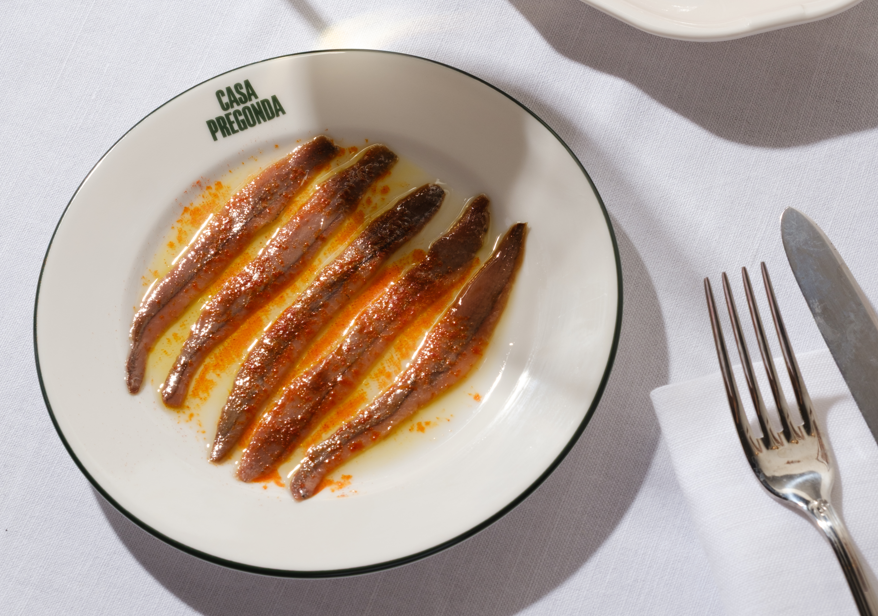In Paris, no Spain, no Gain
By Pomélo
(c) Mickael Bandassak for Casa Pregonda
371. That's the number of days before Spanish song superstar Rosalía ended up visiting Tom Aymerich, co-founder of Café Cortado. Located at 31 rue Charlot, in the Marais district (3rd arrondissement), this Hispanic-inspired coffee shop and its team were waiting for it – proof of this is the T-shirt displaying "Day n°... waiting for Rosalia en Cortado", available on the café's e-shop (€39) and regularly displayed on his Instagram account with almost 42,000 followers.
Skilfully mixing coffee shop pillars (lattes of all kinds but also cookies and carrot cakes) and Spanish specialties (bocadillos, pan con tomate, boquerones, etc.), the place, inaugurated at the beginning of summer 2024, recently took over the opposite sidewalk where Cantina Cortado is now deployed, its "tapassonomic" double, according to gastronomic journalist Emmanuel Rubin in the columns of Le Figaro. Five days a week for the former and every day for the latter, the canteen and café are full. A sign of the recent enthusiasm of the Parisian public for Iberian cuisine, a gastronomy that has been a little snubbed until now.
Bernard Boutboul, president of Gira, a consulting firm in the restaurant industry, is surprised that aioli is only starting to take hold now. "If the capital is full of Italian restaurants, Spanish cuisine has always struggled to make a place for itself in the Parisian landscape ," he analyzes. He continues: "I don't know why, but in Paris, people have always tended to prefer the classic charcuterie and cheese boards, mezze or antipasti rather than tapas." Still, the omnipotence of sharing plates, now a common formula in most mid-range restaurants, could well change the game.
As is often the case, it all began post-covid, when the 20th arrondissement of the city saw Amagat flourish. Inspired by the bodegas and taverns of northern Spain, the business immediately found its audience among gastronomes and trendy people. On the menu: Cantabrian anchovies, patatas bravas, croquetas and other totems of Spanish gastronomy to share, served on plates branded "Amagat", as photogenic as their contents. For some time, the address remained in a virtual monopoly when it came to Iberian cuisine with a Parisian twist. Until recently.
Before the boom, the shudder
We are talking more about a shudder than an explosion of the trend. The signals are still quite weak," says Bernard Boutboul. Still, the openings of addresses with Hispanic influences have been going well since the beginning of the year. In January, restaurateur Toufik Seddik launched Buenas (10th arrondissement) on this model, in order to pay tribute to Spanish cuisine, "which is not at all highlighted in France," he confided in March to the newspaper Le Monde.
In June, it was this time the turn of Casa Pregonda (2nd arrondissement) to see the light of day on the initiative of the trio formed by Valentine Dubois, Nicolas Hoyet – both artistic directors – and chef Alexandre Giesbert (already at the origin of the Daroco restaurant). An ode to Menorcan cuisine dear to all these beautiful people, which takes the form of about thirty proposals, to be shared or not. Like this rice with squid ink topped with carabineros (a kind of bright red prawns) and hints of aioli. But also these ultra-creamy tortillas available in three more or less traditional recipes (aioli and candied pepper; pimentón mayonnaise, txistorra; raw cream, Osetra caviar). Or the gilda, a pintxo consisting of a small pike garnished with an olive, an anchovy and small green peppers, which has also been on the menu of many trendy restaurants and bars in recent times (Cravan, Le Canard Sauvage, Mesures, etc.).

The same goes for burnt cheesecake, this emblem of Basque gastronomy, which has been very popular lately. " It all started at La Viña restaurant in San Sebastian, where the recipe was born in the 1990s. Since then, it has been recognized by its very Instagrammable look and its intense taste, deeper than that of American cheesecake, thanks to its burnt crust and its rich but less sweet heart," explains Frédéric Adida, pastry marketing advisor. Adored by the Japanese, Basque cheesecake is more popular than ever in the capital, where it is widely available: with chai spices at Grave (3rd arrondissement), black sesame and matcha at Hoso (4th arrondissement) and Café Shin (1st arrondissement) – three establishments open between the summer of 2024 and last September. One more proof that in Paris, gastronomes who want emotion are asking for a ticket for Spain Mountain.